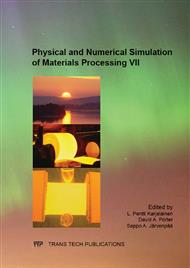p.230
p.236
p.242
p.248
p.253
p.261
p.266
p.277
p.283
Numerical Study on the Removal of Hydrogen and Nitrogen from the Melt of Medium Carbon Steel in Vacuum Tank Degasser
Abstract:
The steelmaking field has been seeing an increased demand of reducing hydrogen and nitrogen in liquid steel before casting. This is often accomplished by vacuum treatment. This paper focuses on developing a numerical model to investigate the removal of hydrogen and nitrogen from the melt of medium carbon steel in a commercial vacuum tank degasser. An activity coefficient model and the eddy-cell expression are implemented in the ANSYS FLUENT code to compute the activities of related elements and mass transfer coefficients of hydrogen and nitrogen in liquid steel. Several cases are simulated to assess the effect of gas flow rate and initial nitrogen content in liquid steel on degassing process and the calculated results are compared with industrial measured data.
Info:
Periodical:
Pages:
253-260
Citation:
Online since:
July 2013
Authors:
Price:
Сopyright:
© 2013 Trans Tech Publications Ltd. All Rights Reserved
Share:
Citation:


